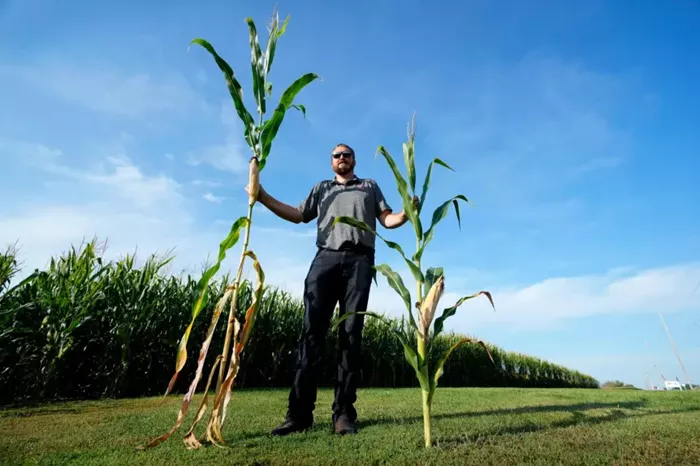WYOMING, Iowa (AP) — A drive through the Midwest’s countryside in late summer reveals towering cornfields, where 12-foot-high stalks dominate the landscape, occasionally interrupted by a distant water tower. These towering plants are as emblematic of rural America as red barns and grazing cows.
However, this familiar sight may soon change. In the coming years, farmers across the Midwest could be seeing fields of shorter corn, standing at just half the height of traditional varieties. Cameron Sorgenfrey, a farmer from eastern Iowa, has been growing this new short corn for several years. His neighbors have shown curiosity about the change. “I think this is going to change agriculture in the Midwest,” Sorgenfrey said.
Bayer Crop Science is trialing this new short corn on approximately 30,000 acres (12,141 hectares) in the Midwest. The goal is to create a crop that can better withstand the increasing frequency of severe windstorms, a trend linked to climate change. The short corn’s reduced height and stronger base enable it to endure winds of up to 50 mph. Researchers use helicopters to test how well the plants handle these conditions.
The shorter plants allow for denser planting, enabling farmers to grow more corn per acre and potentially increase their profits. This is particularly beneficial after several years of low corn prices, which are expected to persist. Additionally, the reduced height of the plants could lead to lower water usage, a significant advantage amid growing concerns about drought.
Corn is a major crop in the U.S., grown on about 90 million acres (36 million hectares) annually. Last year, farmers harvested over 400 million tons (363 million metric tonnes) of corn, primarily for animal feed, ethanol production, and export. The potential shift to shorter corn could have a significant impact, according to Dior Kelley, an assistant professor at Iowa State University. Kelley is studying the development of shorter corn varieties and considers the change a major shift in agriculture.
The push for shorter corn varieties gained momentum after a devastating windstorm, known as a derecho, struck the Midwest in August 2020. The storm, which caused $11 billion in damage and resulted in four fatalities, severely impacted eastern Iowa. The destruction of cornfields, which were only weeks away from harvest, was particularly striking. “It looked like someone had come through with a machete and cut all of our corn down,” Kelley recalled.
Despite enthusiasm for the new short corn, there are concerns. Kelley noted that cobs growing closer to the ground might be more susceptible to diseases and mold. Shorter plants could also face issues such as lodging, where heavy rain causes the corn to fall and grow along the ground.
Bayer has been developing short corn for over two decades, and other companies like Stine Seed and Corteva have been working on similar varieties for about ten years. The aim has been to produce corn that can withstand high winds, but shorter stalks also make it easier for farmers to access fields with equipment for tasks such as applying fungicides or seeding cover crops.
Bayer plans to increase production of short corn by 2027, with hopes that it will become a common sight in fields across the U.S. and potentially other parts of the world. “We see the opportunity of this being the new normal,” said Bayer spokesman Brian Leake.
This story was initially published on September 23, 2024, and updated on September 24, 2024, to correct the amount of corn harvested by U.S. farmers last year, which was over 400 million tons (363 million metric tonnes), not 400 tons (363 metric tonnes).
Related topics:
- Best Time to Plant Flowering Bulbs This Fall
- Sedum: This Easy-to-Grow Purple and Pink Plant Attracts Pollinators
- Celebrate Fall Again at Bios on the Hill’s Autumn Flower Festival 2024


